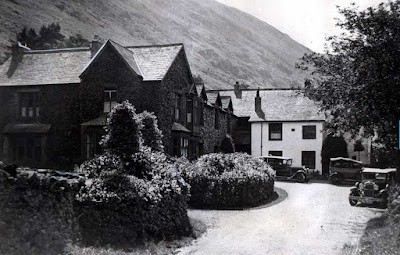Rosemary (Share My Garden) wrote about her visit to Tyneham, a village in Dorset abandoned in the Second World War because it was in an area needed for military training. The residents never returned.
She also remembered, as a child, picking gooseberries in the garden of a house in a village abandoned to the rising waters of a new reservoir.
 |
| Mardale Green |
It reminded me of a passage in ‘Fellwalking With Wainwright’, which has haunted me since I bought the book in 1985. I think of it often. Oh to be able to write like Wainwright.
I will never go to Mardale Head now without thinking of a summer’s day more than forty years ago when I walked over Gatescarth Pass and saw the valley of Mardale for the first time. It was a lovely vista. The floor of the dale was a fresh green strath shadowed by fine trees and deeply inurned between shaggy heights; beyond, receding in the distance, was Haweswater, then a natural lake. It was a peaceful scene, the seclusion of the valley being emphasised by its surround of rough mountains. Mardale was a bright jewel in the dark crown .... I remember that day so well. Many early memories have faded, but not that one. Down in the valley, I went along the lane to the Dun Bull between walls splashed with lichens and draped with ivy. There was no welcome for me at the inn, which for centuries had been a meeting place for farmers and shepherds and the scene of many festive gatherings. It was empty, unoccupied. Around the corner was the small church amongst fine yews: it was a ghostly shell, the interior having been dismantled and the bodies in the graveyard exhumed and reburied elsewhere. The nearby vicarage and a few cottages were deserted and abandoned. This was the hamlet of Mardale Green, delightfully situated in the lee of a wooded hill, but now under sentence of death. Birds trittered in the trees and my footsteps echoed as I walked along the lane but there was no other sound, no sign of life. Even the sheep had gone. There were wild roses in fragrant hedgerows, foxgloves and harebells and wood anemones and primroses in the fields and under the trees, all cheerfully enjoying the warmth and sunshine; but there would be no other summers for them: they were doomed ... Manchester Corporation had taken over the valley and built a great dam. The lake would be submerged beneath a new water level a hundred feet higher. Already the impounded waters were creeping up the valley. Soon the hamlet of Mardale Green would be drowned: the church, the inn, the cottages, and the flowers, would all disappear, sunk without trace, and its history and traditions be forgotten. The flood was coming and it would fill the valley. Nature’s plan for Mardale would be over-rules. Manchester had other plans, to transform Mardale into a great Haweswater Reservoir. And no doubt be very proud of their achievement ... I climbed out of the valley to Kidsty Pike. Looking back at Mardale Green from a distance, its buildings no longer seeming forlorn but cosily encompassed by trees and its silent pastures dappled by sunlight, I thought I had never seen a more beautiful picture. Nor a sadder one.












